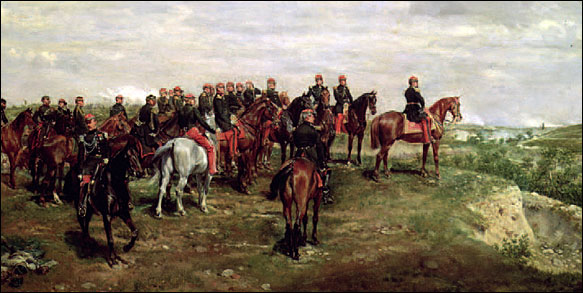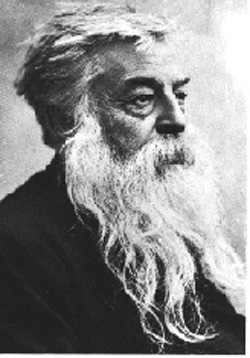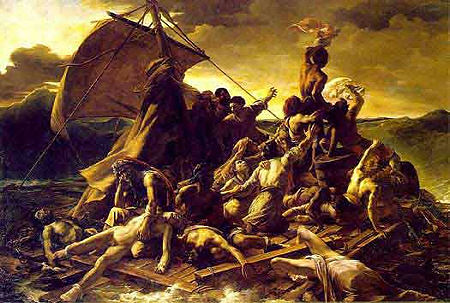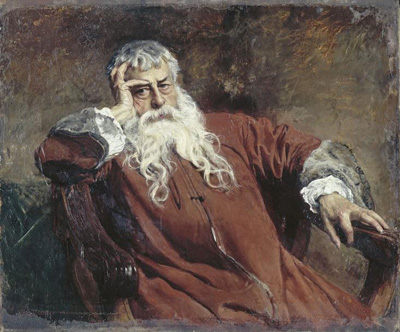Ross King, The Judgment of Paris
CHAPTER ONE
Chez Meissonier
Below you will see some excerpts from a secondary work on art in Paris in the second half of the 19th century. As you read this description of the work of one of the more successfull academic painters of the era try to reconstruct his view of art. Ask yourself questions such as: What does Meissonier's strategy for producing paintings tell us about his notion of what art is? What does he value most highly when making a painting? What does he assume about art? and What does all of this tell us about how the official artists of the period and their audience viewed culture?
ONE GLOOMY JANUARY day in 1863, Jean-Louis-Ernest Meissonier, the world's wealthiest and most celebrated painter, dressed himself in
Jean-Louis-Ernest Meissonier |
the costume of Napoleon Bonaparte and, despite the snowfall, climbed onto the rooftop balcony of his mansion in Poissy. . . .
Ernest Meissonier had occupied the Grande Maison for most of the previous two decades. In his forty-eighth year he was short, arrogant and densely bearded: "ugly, little and mean," one observer put it, "rather a scrap of a man." A friend described him as looking like a professor of gymnastics, and indeed the burly Meissonier was an eager and accomplished athlete, often rising before dawn to rampage through the countryside on horse back, swim in the Seine, or launch himself at an opponent, fencing sword in hand. Only after an hour or two of these exertions would he retire, sometimes still shod in his riding boots, to a studio in the Grande Maison where he spent ten or twelve hours each day crafting on his easel the wonders of precision and meticulousness that had made both his reputation and his fortune.
CHAPTER THREE
Meissonier, Napoleon I in 1814 (1862) |
The Lure of Perfection
IF SOMETHING WAS worth doing, Ernest Meissonier always maintained, it was worth doing properly. He had been conscientious even as a child, showing remarkable patience in tasks like blacking his boots or, when put to work in the druggist's shop, tying up parcels of medicine for customers. He applied the same exacting standards to his paintings, each of which took months, if not years, of concentrated effort. "Although I work under great pressure from all sides," he claimed, "I am always altering. I am never satisfied." Because he often spent one day scraping away the paint he had spent the previous day laboriously applying, he referred to his works-in-progress as "Penelope's webs," an allusion to how each night Odysseus's wife Penelope would unravel the shroud she was weaving on her loom for Laertes, her father-in-law. Sometimes Meissoner did not even bother to scrape away the offending part of the work; he simply repainted the entire canvas, often so many times that the finished product was merely the uppermost layer of a series of palimpsests. "Perfection," he claimed, "lures one on."
Meissonier always spent many months researching his subject, finding out, for example, the precise sort of coats or breeches worn at the court of Louis XV, then hunting for them in rag fairs and market stalls or, failing that, having them specially sewn by tailors. Historical authenticity was taken very seriously in the nineteenth century, not just by Meissonier but also by other artists who likewise went to great lengths to ensure the authenticity of their works. When Théodore Géricault began his masterpiece, The Raft of the "Medusa "-- a huge canvas depicting survivors of a notorious shipwreck -- he had shown exceptional diligence. Starting work in 1818, two years after the event, he pored over published accounts of the ill-fated voyage, interviewed a number of survivors, employed some of them as models, and studied corpses in a hospital morgue. He even hired the carpenter of the Medusa to build him an exact replica of the raft. The resulting canvas was shockingly grisly and violent but accurate in its every gory detail.
This kind of historical reconstruction had always been Meissonier's stock in-trade. Recently he had spent more than three years on a painting that was a mere thirty inches wide by seventeen inches high: The Emperor Napoleon Ill at the Battle of Solferino. The work, a battle scene, had been some thing of a departure for the painter of bonshommes and musketeers. Marking the new direction in Meissonier's career, it took as its subject a victorious battle fought by the French against the Austrians in 1859, when the emperor Napoleon III, together with Victor Emmanuel II, King of Piedmont and Sardinia, tried to oust the Habsburgs from their territories in northern Italy. When hostilities commenced early in the summer of 1859, Meissonier had received a commission from the government to illustrate several scenes from the campaign. He set off for the front in Lombardy, taking with him a servant, two horses and a supply of pencils and paints. Arriving in time to witness a bloody battle fought outside the village of Solferino, he made numerous on-the-spot sketches of the action, barely escaping with his life after several bullets whizzed past his head when he accidentally strayed into the thick of the action in his quest for a good vantage point.
Théodore Géricault, The Raft of the Medusa (1818-1819) |
Meissonier's studies for The Battle of Solferino had continued long after the war ended. At the army camp in Vincennes, east of Paris, he painted further sketches of soldiers, and at the Chateau de Fontainebleau he did portrait studies of both Napoleon III -- who was going to be the focus of the scene -- and his horse, Buckingham. He even made a return trip to Solferino, a year after the battle, to make still more studies of the bleak, dusty landscape. The painting was accepted by the judges, sight unseen, for the Salon of 1861, where Meissonier had been hoping to show the critics that he had risen above his lucrative "musketeer style" to paint something more ambitious in conception. It failed to materialize: the master was still perfecting the work in his studio. Nor did it appear the following year, as announced, at the Universal Exposition in London. Meissonier would not complete the painting until January of 1863, almost four years after his first expedition to Solferino.
The Campaign of France, commissioned while The Battle of Solferino was still on his easel, required equally prolonged and unstinting researches. Starting work in 1860, he consulted Adolphe Thiers, both in person and in print. He interviewed survivors of the 1814 campaign, such as the Due de Mortemart, one of Napoleon's generals. He also consulted Napoleon's valet, an old man named Hubert. He made a special journey to Chantilly to see Napoleon's groom, Pillardeau, whose home was a bizarre shrine dedicated to the memory of Napoleon and the Grande Armee, complete with papier-mache replicas of the kind of bread eaten by the soldiers. Meissonier thereby became an expert on every aspect of Napoleon's life, from how he changed his breeches every day because he soiled them with snuff, to how he undressed himself -- for reasons of modesty -- only in total darkness.
Meissonier did not begin the actual painting of any of his works until he had first made numerous preparatory sketches and studies. And he did
Meissonier, Self-Portrait (1889) |
not begin these until he had worked out the composition of the painting in the most elaborate detail, usually by means of a three-dimensional scale model of the scene. A number of painters had resorted to this strategy, from Michelangelo, who made wax figurines of many of the characters he painted, to the eighteenthcentury English landscapist Thomas Gainsborough, who fashioned tabletop models with sand, moss, twigs, bits of mirror for water or sky, and miniature horses and cows. But Meissonier, as ever, took matters a step or two farther. Thus, for The Campaign of France he sculpted in wax a series of highly detailed models, some six to eight inches high, of Napoleon and his generals, as well as the horses on which they sat. These models he then arranged in his studio on a wooden platform four feet square. He also made models of tumbrils and wagons, which he proceeded to drag across a muddy landscape carefully molded from clay spread on top of the platform-to create the fur rowed road along which Napoleon trekked with his generals. He prided himself on these creations, considering himself, according to a friend, "by turns tailor, saddler, joiner, cabinetmaker."
Absolutely nothing was left to chance or imagination; everything had to be rigorously and impeccably correct. Meissonier had faced a problem, though, with his tableau vivant for The Campaign of France. Despite the presence of Napoleon and his generals, this new painting was conceived as, first and foremost, a snowscape: a panorama in which the Grande Armee plods across a vast expanse of snow beneath a leaden sky. And since Meissonier would not paint anything without first having the correct specimen before his eyes, he had naturally found himself in need of snow. So across the expanse of furrowed clay he had sprinkled handfuls of finely granulated sugar and, to give his snow its glitter, pinches of salt. With a shod hoof, likewise executed in miniature, he then meticulously pressed the imprints of the horses' feet. The leadership of the Grande Armee was thereby devised in perfect effigy against a snowy landscape.

Meissonier, Napoleon III at Solferino (1864)


